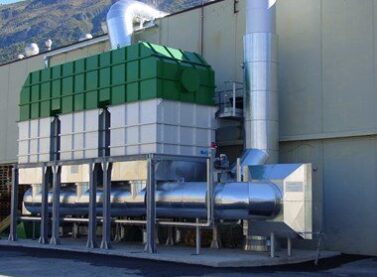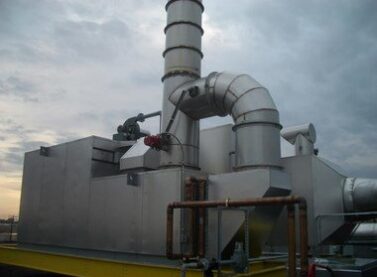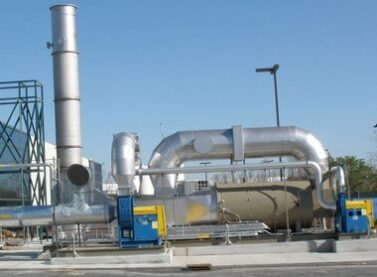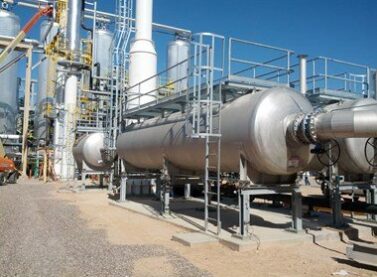Volatile organic compounds removal
At Condorchem Envitech we design and install plants for the treatment and removal of VOC (volatile organic compounds). We always supply the solution that better fits our customer needs, as the most efficient system for VOC removal can vary depending on the particularities of each case. Some of the aspects to consider are the air flow, VOC concentration, variability of the flow and the composition, and space availability, among others.
Thanks to our partnership with the CMM Group, we guarantee that we will always install the most suitable system for the elimination or reduction of VOC, we have a wide range of technologies, among which are the following:
Our technologies for VOC removal
What are VOCs?
There are more than a thousand VOCs: a long list of chemical compounds which are characterized as gases or liquids at room temperature, usually contain less than 12 carbon atoms as well as elements such as oxygen, fluorine, bromine, sulfur and nitrogen.
The most abundant VOCs in the air are methane, toluene, butane, pentane, ethane, benzene, propane and ethylene. These compounds are generated in all those industrial processes in which organic solvents (such as acetaldehyde, benzene, aniline, carbon tetrachloride, 1,1,1-trichloroethane, acetone, ethanol, among others) are used. Their danger to the health of people and the harmful effects they can have on the environment vary depending on the compound itself, and so they are classified into 3 groups:
- Extremely dangerous compounds for health. This is the case for benzene, vinyl chloride and 1,2-dichloroethane, among others.
- Class A compounds: those which could cause significant damage to the environment, such as acetaldehyde, aniline and trichloroethylene.
- Class B Compounds: this group consists of those VOCs with a minor impact on the environment, such as acetone or ethanol, among many others.
In addition, all VOCs, in combination with nitrogen oxides and sunlight, are ozone precursors at ground level (tropospheric ozone), which is very bad for health as it causes severe respiratory damage.
Also problematic is that VOCs are usually odoriferous substances, and can therefore have a very negative impact on the environment when produced.
Processes and technologies
The regulations controlling the emission of VOCs into the atmosphere is increasingly restrictive as they must be appropriately treated and removed.
At Condorchem Envitech, we have the appropriate technologies, both destructive and non-destructive, for the treatment of volatile organic compound (VOC) emissions generated in industrial processes, and for their adaptation to the limitation of VOC emissions according to the provisions of the current regulations in each country.
We are experts in the design of the most efficient VOC treatment process which depends on different factors: e.g. air flow to treat and its variability, VOC concentration in the air and its variability and space availability.
The most efficient processes for the treatment of VOCs are the following:
Gas phase advanced oxidation (GPAO): this technique consists of 4 stages. In the first stage, the air to be treated is subjected to an absorption process in water and ozone. The soluble gases that dissolve in the water are oxidised by the ozone to CO2. In stage 2, ozone is added to the gases resulting from stage 1 and the mixture is irradiated with high-intensity ultraviolet light. The ozone is transformed into OH radicals, which are extremely reactive with the VOCs. The oxidation produces a particulate aerosol, which are separated in stage 3 with an electrostatic precipitator. The resulting air, which is free of VOCs and of odours, may be released into the atmosphere. Finally, in stage 4 the remaining ozone is transformed into oxygen with a catalyst.
It is a robust technique for a great variety of VOCs, which is ideal for low flows, with a low operating cost and high energy efficiency.
Regenerative thermal oxidation (RTO): this process is carried out inside towers filled with ceramic material in which the pollutants are oxidised at 750ºC. The system has a thermal efficiency greater than 95%, such that the consumption of gas to maintain the temperature is low.
It is a very versatile technique as regards the flow to be treated (1,000-100,000 Nm3/h), which is ideal for medium-high concentrations of VOCs and optimal for a great variety of VOCs.
Regenerative catalytic oxidation (RCO): this process is similar to RTO but the presence of a catalyst in the combustion chamber makes it possible to operate at lower temperatures, in the range of 300-350ºC. The system has a thermal efficiency greater than 98% and does not consume gas when the autothermal point is reached.
It is an ideal technique for low or medium airflows (1,000-30,000 Nm3/h) for medium or low VOC concentration, which has a low operating cost.
Zeolite rotor concentrator + RTO: this technique is based on the operation of a wheel with a porous material (Zeolite) in which the VOC accumulate through an adsorption process to obtain a higher concentration. The VOCs are then treated in a regenerative thermal oxidation (RTO) unit.
It is an ideal technique for treating large air flows that contain low concentrations of VOC.
Given the danger for people and the environment, VOC emissions must be controlled and, if necessary, treated. To do so, the technique that best fits the particular conditions in each case should be implemented. This will depend on parameters such as the flow under treatment, concentration of VOCs, conditions of the operation, etc.
Sectors
There are many activities that could produce VOC emissions. They generally belong to the follow industrial sectors:





